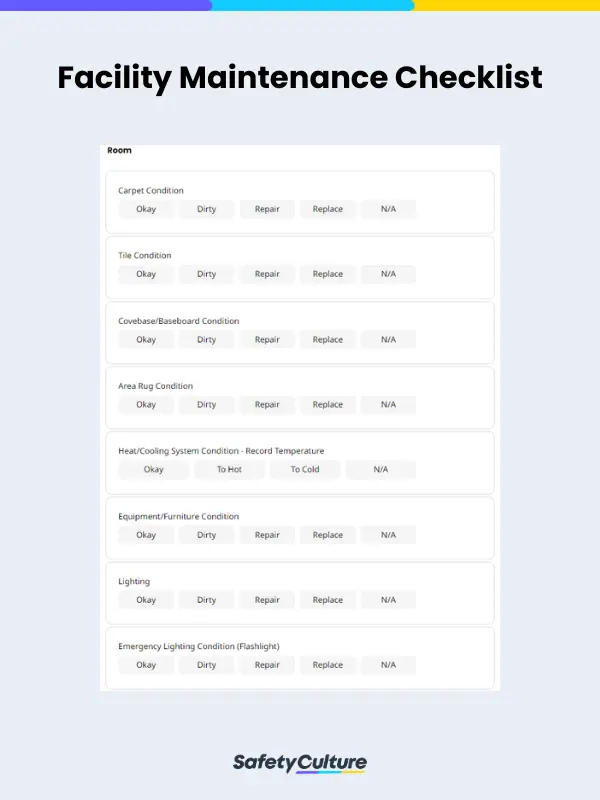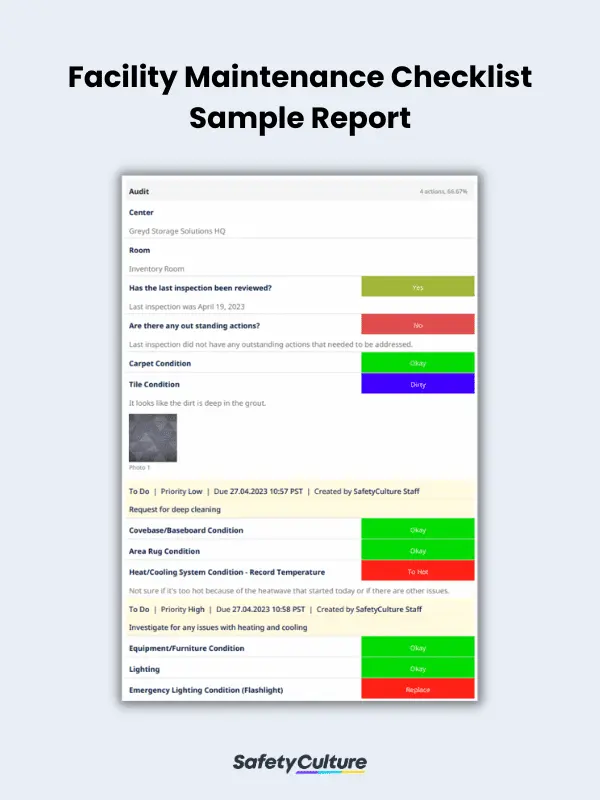What is a Facility Maintenance Checklist?
A facility maintenance checklist is a document that can help guide facility inspections. It provides a list of items to look out for in a facility maintenance check and the proper processes how to do them.
Importance
Facility maintenance involves a wide range of tasks, including inspecting, repairing, and replacing equipment, cleaning, and upkeeping the facility. Neglecting proper facility maintenance and facility management practices can lead to downtime, loss of productivity, and even accidents, which can result in costly repairs, lawsuits, or other legal issues.
However, facility maintenance can be long and tiresome. A facility maintenance checklist helps ensure that all the required tasks for facility maintenance are performed and that all aspects of the facility are inspected and maintained regularly. It also serves as a safeguard against forgetting anything, as with a checklist, you can go through each step of the facility maintenance process in detail.
A facility maintenance checklist also provides the following benefits:
- Improved Safety: A major benefit of using a facility maintenance checklist is that it helps manage and improve safety in the workplace. By recording the risks associated with each facility, it can be easier to create the proper plans to address them.
- Improved Efficiency: A facility maintenance checklist can help maintain equipment and systems regularly, thus improving work efficiency and reducing downtime. This can lead to increased productivity and reduced costs. It can also help extend the life of equipment and systems, reducing the need for replacements.
- Compliance: Many facilities are required to comply with different safety regulations to be deemed fit for use. A facility maintenance checklist can help promote more regular maintenance checks, ensuring that the facilities stay compliant with the required regulations and safety standards to follow.
- Peace of Mind: By regularly using a facility maintenance checklist and conducting regular inspections, businesses can have peace of mind, knowing that their facility is safe, efficient, and operating at optimal levels.
What to Include in a Facility Maintenance Checklist
Facility maintenance checklists come in many forms. Some would prompt you to inspect all facilities at a glance, while others would sort and group them into function, room, building, or maintenance schedule.
However, a typical facility maintenance checklist usually includes sections or questions for the following:
- Previous Inspections: This can be used to detail the last inspection, such as the date it was conducted and the findings discovered from then. This will be used as a reference for any issues discovered during the inspection.
- Electrical systems: Electrical systems, including wiring, outlets, switches, and lighting, should be inspected regularly to ensure they are functioning correctly and safely.
- HVAC systems: Heating, ventilation, and air conditioning (HVAC) systems should also be inspected, as they are essential for maintaining comfortable temperatures and good air quality in a building. Regular maintenance and cleaning of filters, ducts, and other components are necessary to ensure these systems are operating correctly and efficiently.
- Plumbing systems: Plumbing systems include pipes, drains, toilets, sinks, and other fixtures in places such as bathrooms, kitchens, and the like Regular inspection and maintenance can help prevent leaks, clogs, and other plumbing problems that can lead to water damage, mold growth, and other issues.
- Fire safety systems: Fire safety systems, such as fire alarms, sprinklers, and extinguishers, should be inspected regularly to ensure they are in good working order, prevent fires, and minimize damage in case of an emergency.
- Security systems: Security systems, such as alarms and surveillance cameras, are essential for ensuring the safety of people and property in a building. Regular inspections and maintenance can help ensure these systems are working correctly and provide reliable protection.
- Outdoor areas: Your facilities’ and buildings’ outdoor areas, such as parking lots, sidewalks, and landscaping, should also be included in a facility maintenance checklist. Regular inspections and maintenance can help prevent accidents, maintain the building’s curb appeal, and provide a safe environment for your employees and others that may come by.
- Sign-off: Finish off your facility maintenance checklist by requiring all inspectors to sign off at the end. This will make it easier for future facility maintenance inspectors to know who to refer to if something goes wrong or if they have any questions.
A facility maintenance checklist can be done traditionally, that is, with pen and paper. However, it is now preferred to utilize a digital checklist solution instead. Creating and managing a checklist for facility maintenance and inspections can be more beneficial in the long run because of the following benefits:
- Improved accessibility: With a digital facility maintenance checklist solution, you can access your checklists anywhere.
- More secure storage: Store your digital checklists in the cloud where all your data will be protected.
- More well-rounded inspections: Digital checklist solutions today can now be used in conjunction with other workplace safety and operation improvement software. By going digital, you can create a better workflow by integrating your checklists with other work software. You can also perform other process improvement tasks, such as training programs with a dedicated software.
How to Implement and Use This Checklist
Implementing and using a facility maintenance checklist can help keep your building in top condition and prevent costly downtime. Ideally, it should be used before and after using the facilities to be inspected. Conducting an inspection before using your facilities helps ensure that there are no possible safety issues or hazards that can happen while they are in use.
On the other hand, conducting a secondary inspection after use helps check for any issues that may have happened in the time that passed. This can also help the next user or other users to avoid doing certain tasks with the facilities that can cause them harm.
By implementing and using a facility maintenance checklist effectively, you can ensure that your building is well-maintained and operating at its full potential. This can save you time, money, and headaches in the long run and help you avoid costly repairs and downtime.
Here are some steps to follow to ensure that your maintenance checklist is implemented and used effectively:
- Train staff on using the checklist: Before implementing the checklist, ensure that all maintenance staff is trained on how to use it effectively. This includes understanding the tasks listed, knowing how to complete them correctly, and understanding the importance of timely completion.
- Assign tasks and responsibilities: Delegate the right tasks and responsibilities to each staff member or team to ensure that all tasks are completed regularly and on time.
- Set up a schedule: Use the checklist to create a maintenance schedule for the entire year, including tasks that need to be done daily, weekly, monthly, quarterly, or annually. It would be best to also use a digital scheduling solution that can work with your checklist so as to streamline the process.
- Monitor progress: Regularly monitor the progress of maintenance tasks and ensure that they are completed on time. Consider setting up alerts to notify you of issues, overdue actions, or missed deadlines.
- Record and analyze data: Keep detailed records of maintenance activities and analyze the data regularly to identify trends and areas for improvement.
- Conduct regular reviews: Conduct regular reviews of the checklist to ensure that it remains effective and relevant. This can include updating tasks, adjusting schedules, or adding new elements as needed.
Here is a sample report showing a facility maintenance checklist in use:
FAQs about Facility Maintenance Checklists
It is often the facility manager who creates, maintains, and manages facility maintenance checklists. Doing so is part of their job to make sure that all systems are working as intended and that their personnel is at their best.
A building maintenance checklist and a facility maintenance checklist are two checklists that often work hand in hand together. However, they have different purposes.
Conceptually, building maintenance refers to the act of caring for buildings and their equipment. A building maintenance checklist is used for inspecting and maintaining a building structure to ensure that it is in working order.
On the other hand, a facility maintenance checklist focuses more on improving the experience of people working in a certain building by performing regular inspections of what is inside the building. It can still be used to inspect building maintenance, but its angle will be modified to focus on how the building is affecting the comfort and experience of workers.
Facility maintenance should be conducted regularly. It can be done daily before and after use or on a weekly, monthly, quarterly, or annual basis.




